Analysis of Knowledge Management and Information Systems at Tesco Plc
VerifiedAdded on 2023/01/09
|17
|4371
|93
Report
AI Summary
This report provides a comprehensive analysis of Tesco Plc's knowledge management and information systems. It begins with an introduction to Tesco's corporate objectives, business overview, structure, and business model. The main body delves into internal and external factors impacting the business, utilizing SWOT, PESTLE, and Porter's Five Forces models. The report then recommends a suitable knowledge management information system, justifying its potential to improve both current and future performance. Finally, it critically assesses three key management implementation challenges faced during the implementation of the new system. The report concludes with a summary of findings and a list of references.
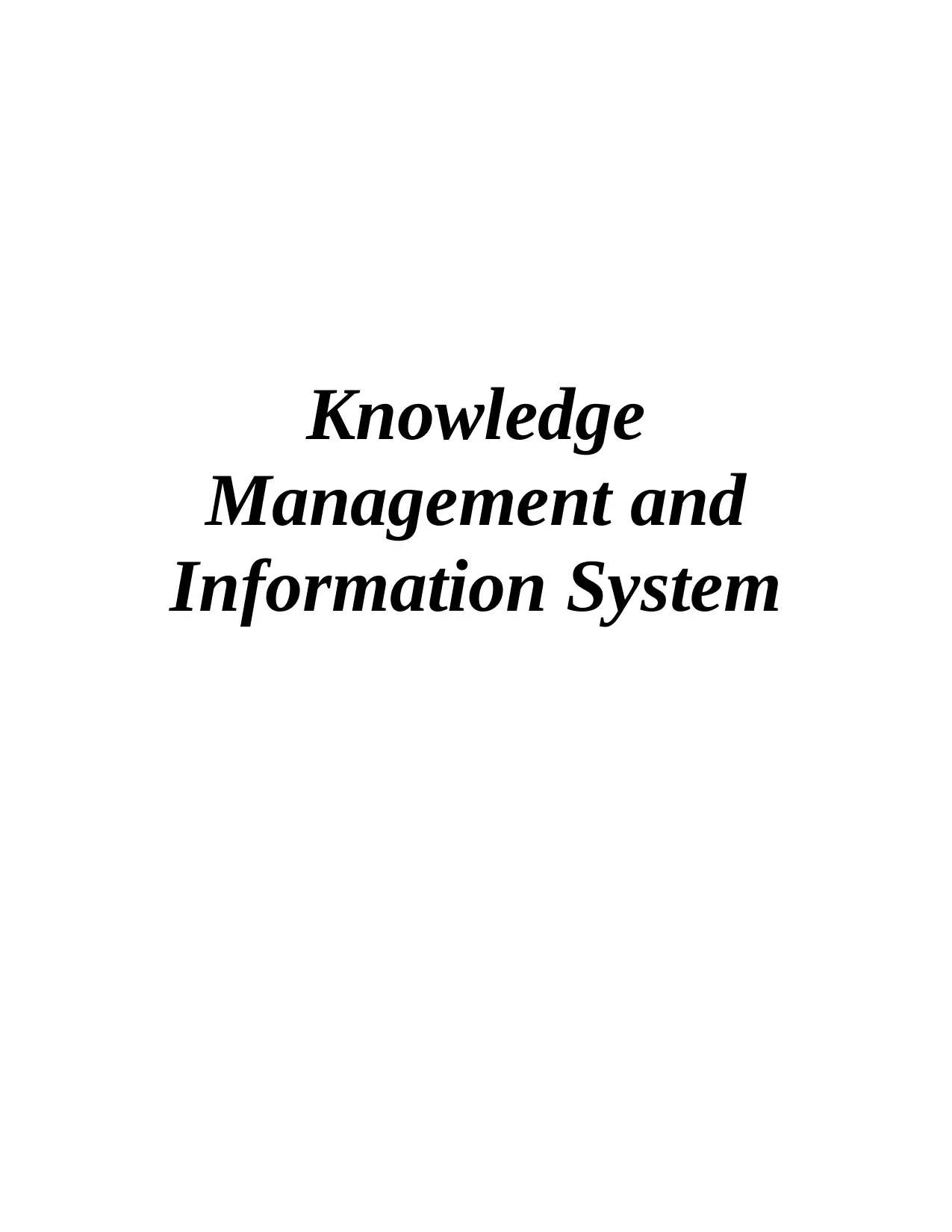
Knowledge
Management and
Information System
Management and
Information System
Paraphrase This Document
Need a fresh take? Get an instant paraphrase of this document with our AI Paraphraser
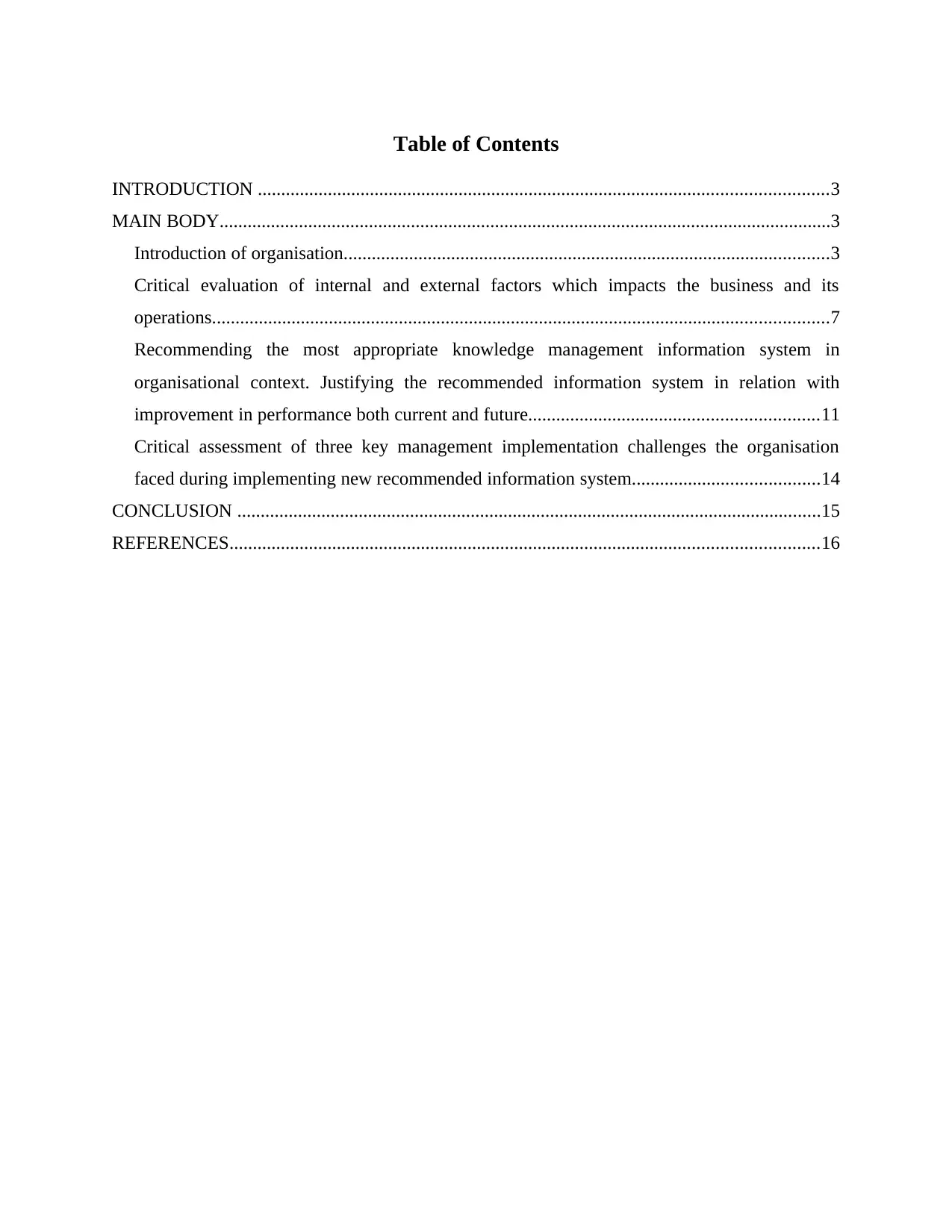
Table of Contents
INTRODUCTION ..........................................................................................................................3
MAIN BODY...................................................................................................................................3
Introduction of organisation........................................................................................................3
Critical evaluation of internal and external factors which impacts the business and its
operations....................................................................................................................................7
Recommending the most appropriate knowledge management information system in
organisational context. Justifying the recommended information system in relation with
improvement in performance both current and future..............................................................11
Critical assessment of three key management implementation challenges the organisation
faced during implementing new recommended information system........................................14
CONCLUSION .............................................................................................................................15
REFERENCES..............................................................................................................................16
INTRODUCTION ..........................................................................................................................3
MAIN BODY...................................................................................................................................3
Introduction of organisation........................................................................................................3
Critical evaluation of internal and external factors which impacts the business and its
operations....................................................................................................................................7
Recommending the most appropriate knowledge management information system in
organisational context. Justifying the recommended information system in relation with
improvement in performance both current and future..............................................................11
Critical assessment of three key management implementation challenges the organisation
faced during implementing new recommended information system........................................14
CONCLUSION .............................................................................................................................15
REFERENCES..............................................................................................................................16
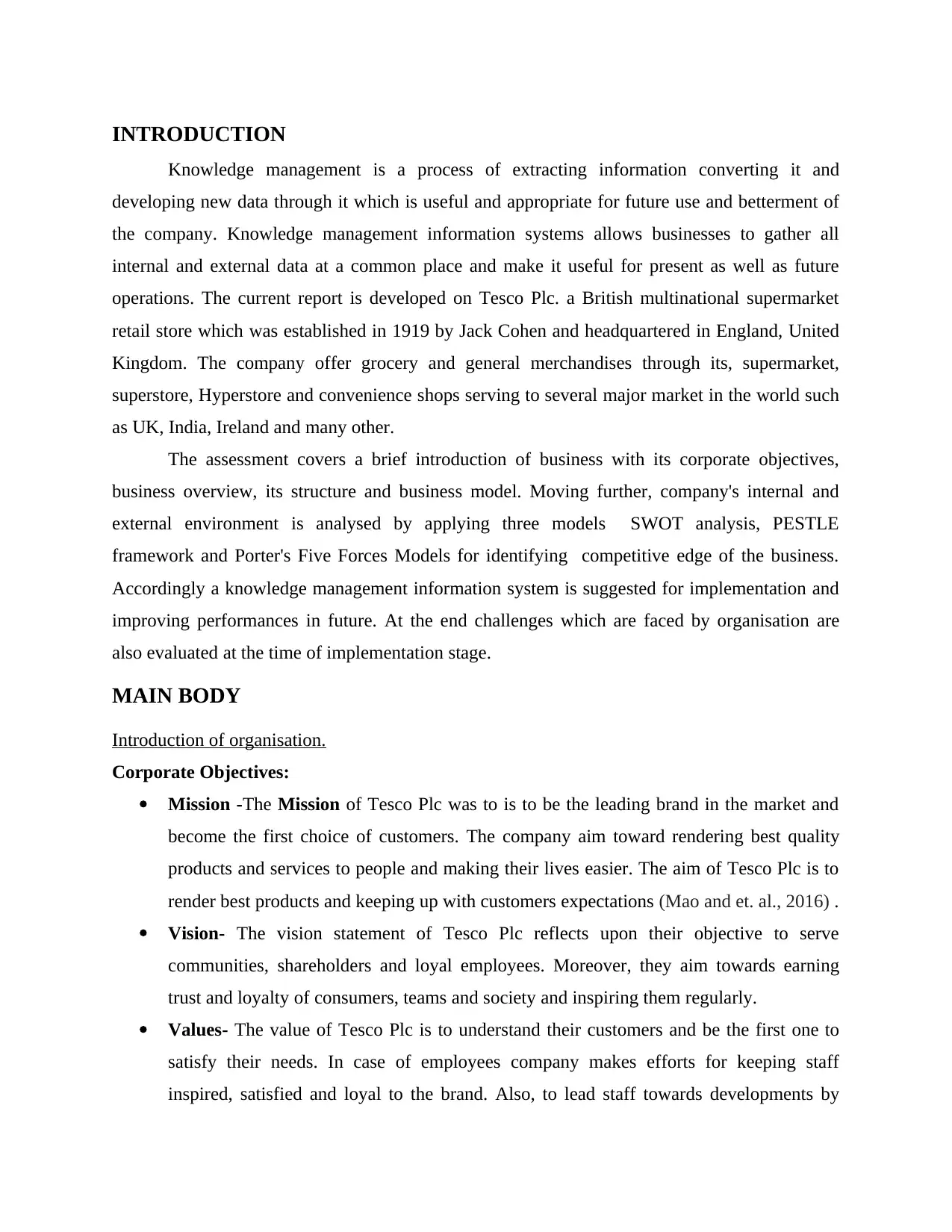
INTRODUCTION
Knowledge management is a process of extracting information converting it and
developing new data through it which is useful and appropriate for future use and betterment of
the company. Knowledge management information systems allows businesses to gather all
internal and external data at a common place and make it useful for present as well as future
operations. The current report is developed on Tesco Plc. a British multinational supermarket
retail store which was established in 1919 by Jack Cohen and headquartered in England, United
Kingdom. The company offer grocery and general merchandises through its, supermarket,
superstore, Hyperstore and convenience shops serving to several major market in the world such
as UK, India, Ireland and many other.
The assessment covers a brief introduction of business with its corporate objectives,
business overview, its structure and business model. Moving further, company's internal and
external environment is analysed by applying three models SWOT analysis, PESTLE
framework and Porter's Five Forces Models for identifying competitive edge of the business.
Accordingly a knowledge management information system is suggested for implementation and
improving performances in future. At the end challenges which are faced by organisation are
also evaluated at the time of implementation stage.
MAIN BODY
Introduction of organisation.
Corporate Objectives:
Mission -The Mission of Tesco Plc was to is to be the leading brand in the market and
become the first choice of customers. The company aim toward rendering best quality
products and services to people and making their lives easier. The aim of Tesco Plc is to
render best products and keeping up with customers expectations (Mao and et. al., 2016) .
Vision- The vision statement of Tesco Plc reflects upon their objective to serve
communities, shareholders and loyal employees. Moreover, they aim towards earning
trust and loyalty of consumers, teams and society and inspiring them regularly.
Values- The value of Tesco Plc is to understand their customers and be the first one to
satisfy their needs. In case of employees company makes efforts for keeping staff
inspired, satisfied and loyal to the brand. Also, to lead staff towards developments by
Knowledge management is a process of extracting information converting it and
developing new data through it which is useful and appropriate for future use and betterment of
the company. Knowledge management information systems allows businesses to gather all
internal and external data at a common place and make it useful for present as well as future
operations. The current report is developed on Tesco Plc. a British multinational supermarket
retail store which was established in 1919 by Jack Cohen and headquartered in England, United
Kingdom. The company offer grocery and general merchandises through its, supermarket,
superstore, Hyperstore and convenience shops serving to several major market in the world such
as UK, India, Ireland and many other.
The assessment covers a brief introduction of business with its corporate objectives,
business overview, its structure and business model. Moving further, company's internal and
external environment is analysed by applying three models SWOT analysis, PESTLE
framework and Porter's Five Forces Models for identifying competitive edge of the business.
Accordingly a knowledge management information system is suggested for implementation and
improving performances in future. At the end challenges which are faced by organisation are
also evaluated at the time of implementation stage.
MAIN BODY
Introduction of organisation.
Corporate Objectives:
Mission -The Mission of Tesco Plc was to is to be the leading brand in the market and
become the first choice of customers. The company aim toward rendering best quality
products and services to people and making their lives easier. The aim of Tesco Plc is to
render best products and keeping up with customers expectations (Mao and et. al., 2016) .
Vision- The vision statement of Tesco Plc reflects upon their objective to serve
communities, shareholders and loyal employees. Moreover, they aim towards earning
trust and loyalty of consumers, teams and society and inspiring them regularly.
Values- The value of Tesco Plc is to understand their customers and be the first one to
satisfy their needs. In case of employees company makes efforts for keeping staff
inspired, satisfied and loyal to the brand. Also, to lead staff towards developments by
⊘ This is a preview!⊘
Do you want full access?
Subscribe today to unlock all pages.

Trusted by 1+ million students worldwide
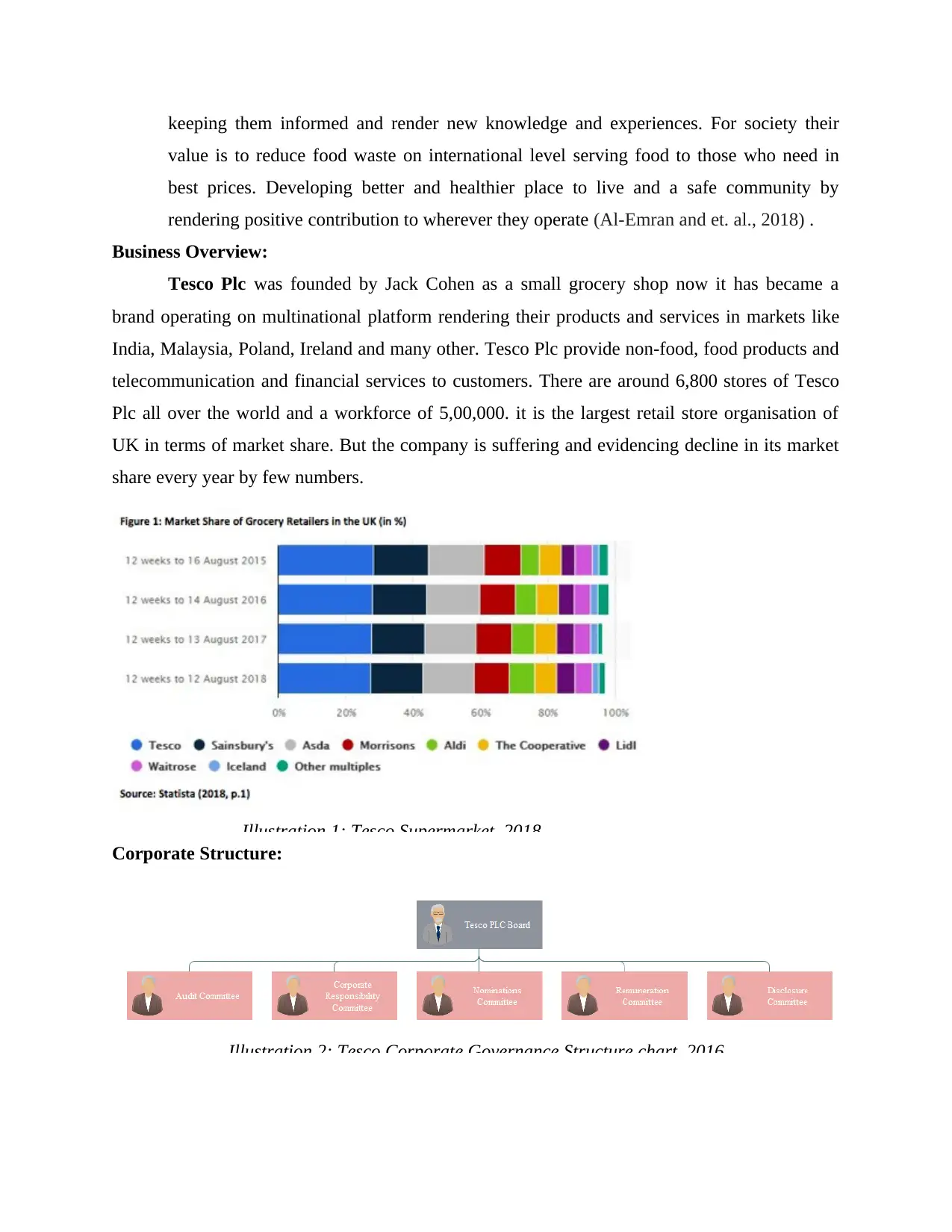
keeping them informed and render new knowledge and experiences. For society their
value is to reduce food waste on international level serving food to those who need in
best prices. Developing better and healthier place to live and a safe community by
rendering positive contribution to wherever they operate (Al-Emran and et. al., 2018) .
Business Overview:
Tesco Plc was founded by Jack Cohen as a small grocery shop now it has became a
brand operating on multinational platform rendering their products and services in markets like
India, Malaysia, Poland, Ireland and many other. Tesco Plc provide non-food, food products and
telecommunication and financial services to customers. There are around 6,800 stores of Tesco
Plc all over the world and a workforce of 5,00,000. it is the largest retail store organisation of
UK in terms of market share. But the company is suffering and evidencing decline in its market
share every year by few numbers.
Illustration 1: Tesco Supermarket, 2018
Corporate Structure:
Illustration 2: Tesco Corporate Governance Structure chart, 2016
value is to reduce food waste on international level serving food to those who need in
best prices. Developing better and healthier place to live and a safe community by
rendering positive contribution to wherever they operate (Al-Emran and et. al., 2018) .
Business Overview:
Tesco Plc was founded by Jack Cohen as a small grocery shop now it has became a
brand operating on multinational platform rendering their products and services in markets like
India, Malaysia, Poland, Ireland and many other. Tesco Plc provide non-food, food products and
telecommunication and financial services to customers. There are around 6,800 stores of Tesco
Plc all over the world and a workforce of 5,00,000. it is the largest retail store organisation of
UK in terms of market share. But the company is suffering and evidencing decline in its market
share every year by few numbers.
Illustration 1: Tesco Supermarket, 2018
Corporate Structure:
Illustration 2: Tesco Corporate Governance Structure chart, 2016
Paraphrase This Document
Need a fresh take? Get an instant paraphrase of this document with our AI Paraphraser
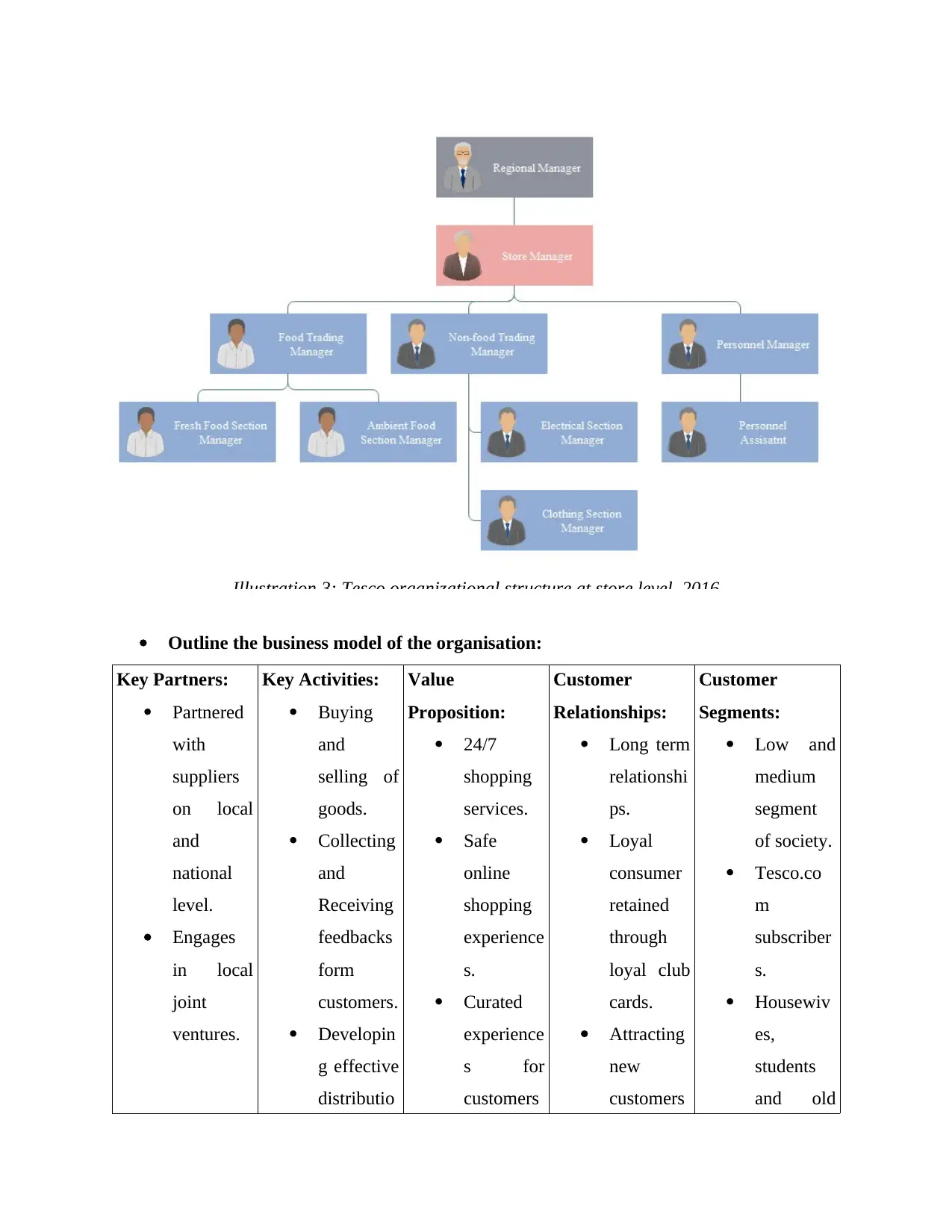
Illustration 3: Tesco organizational structure at store level, 2016
Outline the business model of the organisation:
Key Partners:
Partnered
with
suppliers
on local
and
national
level.
Engages
in local
joint
ventures.
Key Activities:
Buying
and
selling of
goods.
Collecting
and
Receiving
feedbacks
form
customers.
Developin
g effective
distributio
Value
Proposition:
24/7
shopping
services.
Safe
online
shopping
experience
s.
Curated
experience
s for
customers
Customer
Relationships:
Long term
relationshi
ps.
Loyal
consumer
retained
through
loyal club
cards.
Attracting
new
customers
Customer
Segments:
Low and
medium
segment
of society.
Tesco.co
m
subscriber
s.
Housewiv
es,
students
and old
Outline the business model of the organisation:
Key Partners:
Partnered
with
suppliers
on local
and
national
level.
Engages
in local
joint
ventures.
Key Activities:
Buying
and
selling of
goods.
Collecting
and
Receiving
feedbacks
form
customers.
Developin
g effective
distributio
Value
Proposition:
24/7
shopping
services.
Safe
online
shopping
experience
s.
Curated
experience
s for
customers
Customer
Relationships:
Long term
relationshi
ps.
Loyal
consumer
retained
through
loyal club
cards.
Attracting
new
customers
Customer
Segments:
Low and
medium
segment
of society.
Tesco.co
m
subscriber
s.
Housewiv
es,
students
and old
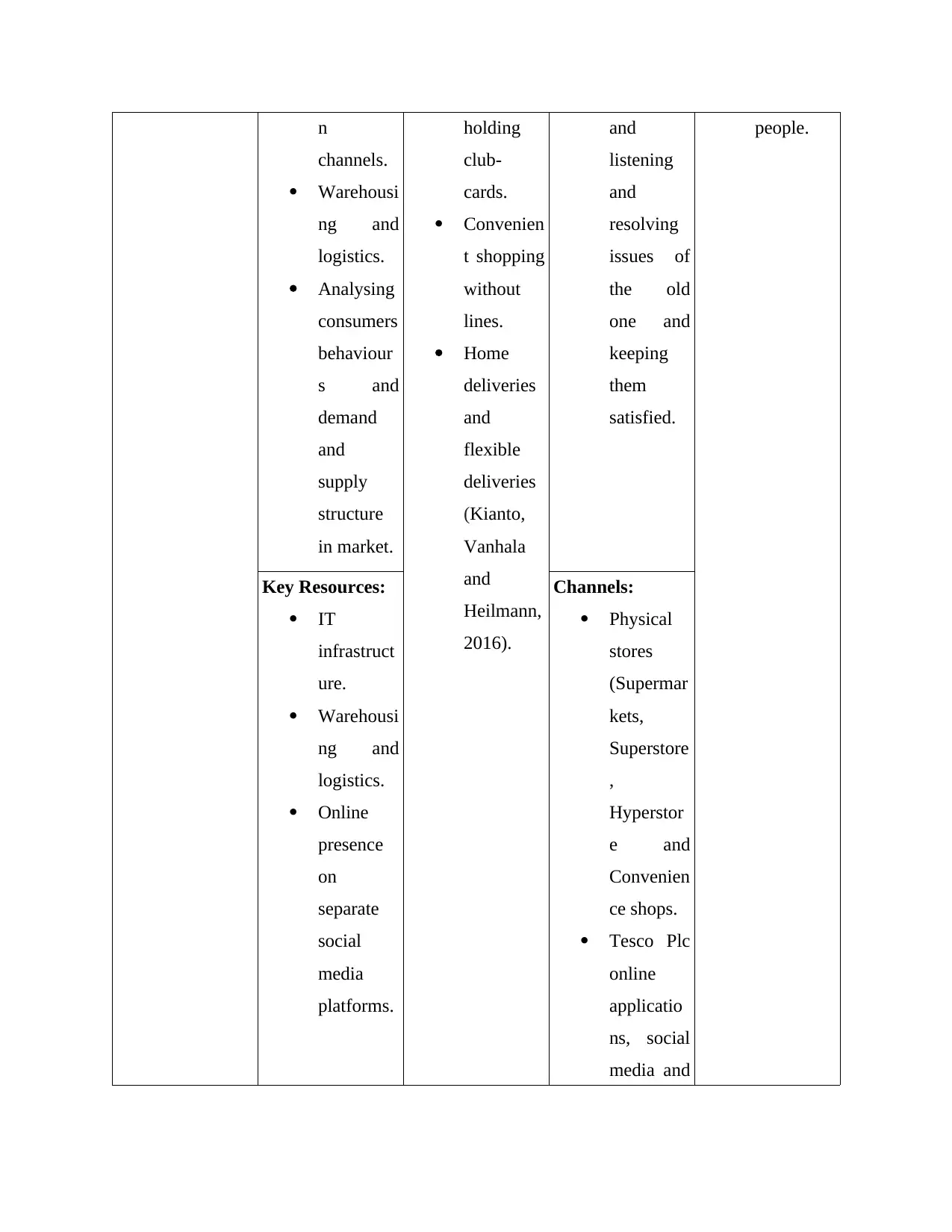
n
channels.
Warehousi
ng and
logistics.
Analysing
consumers
behaviour
s and
demand
and
supply
structure
in market.
holding
club-
cards.
Convenien
t shopping
without
lines.
Home
deliveries
and
flexible
deliveries
(Kianto,
Vanhala
and
Heilmann,
2016).
and
listening
and
resolving
issues of
the old
one and
keeping
them
satisfied.
people.
Key Resources:
IT
infrastruct
ure.
Warehousi
ng and
logistics.
Online
presence
on
separate
social
media
platforms.
Channels:
Physical
stores
(Supermar
kets,
Superstore
,
Hyperstor
e and
Convenien
ce shops.
Tesco Plc
online
applicatio
ns, social
media and
channels.
Warehousi
ng and
logistics.
Analysing
consumers
behaviour
s and
demand
and
supply
structure
in market.
holding
club-
cards.
Convenien
t shopping
without
lines.
Home
deliveries
and
flexible
deliveries
(Kianto,
Vanhala
and
Heilmann,
2016).
and
listening
and
resolving
issues of
the old
one and
keeping
them
satisfied.
people.
Key Resources:
IT
infrastruct
ure.
Warehousi
ng and
logistics.
Online
presence
on
separate
social
media
platforms.
Channels:
Physical
stores
(Supermar
kets,
Superstore
,
Hyperstor
e and
Convenien
ce shops.
Tesco Plc
online
applicatio
ns, social
media and
⊘ This is a preview!⊘
Do you want full access?
Subscribe today to unlock all pages.

Trusted by 1+ million students worldwide
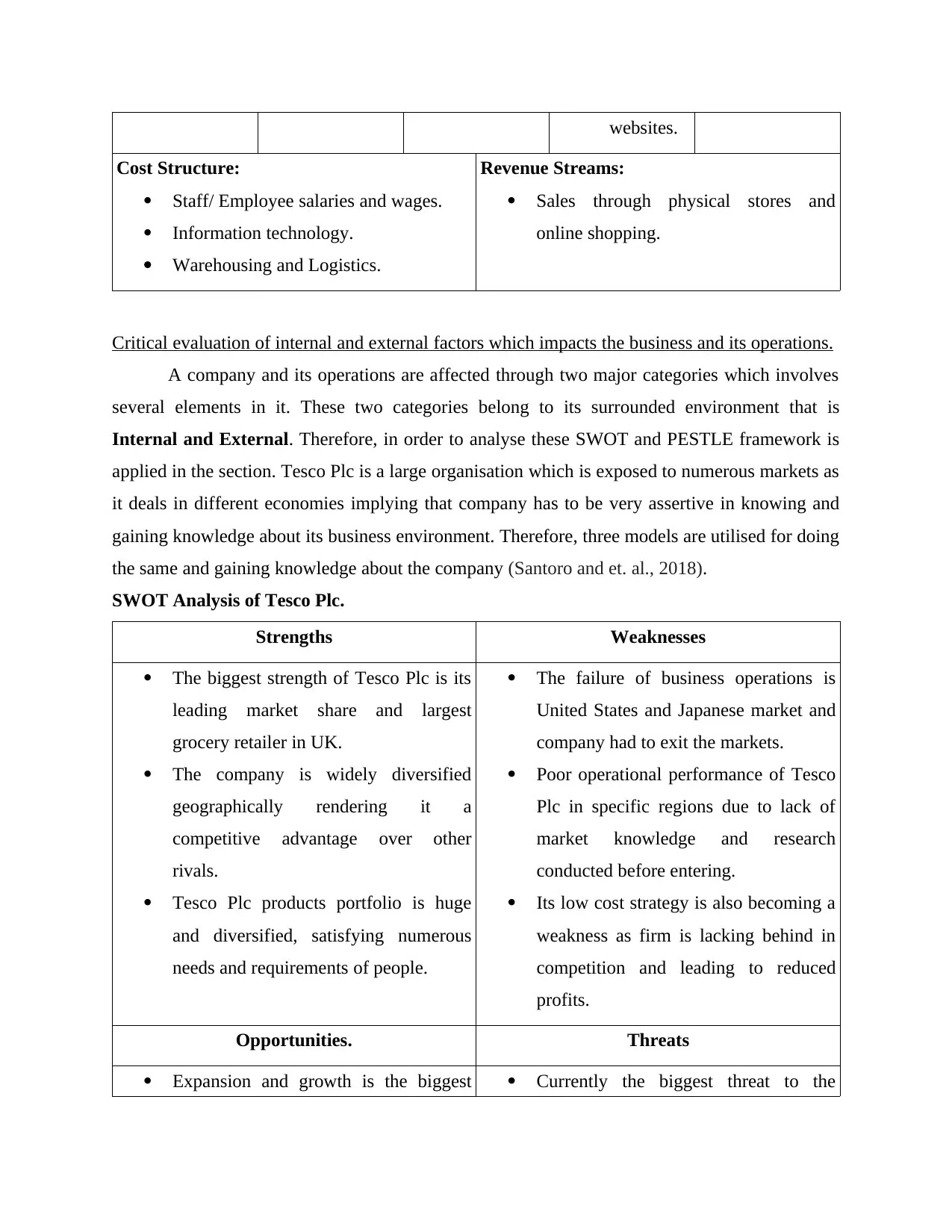
websites.
Cost Structure:
Staff/ Employee salaries and wages.
Information technology.
Warehousing and Logistics.
Revenue Streams:
Sales through physical stores and
online shopping.
Critical evaluation of internal and external factors which impacts the business and its operations.
A company and its operations are affected through two major categories which involves
several elements in it. These two categories belong to its surrounded environment that is
Internal and External. Therefore, in order to analyse these SWOT and PESTLE framework is
applied in the section. Tesco Plc is a large organisation which is exposed to numerous markets as
it deals in different economies implying that company has to be very assertive in knowing and
gaining knowledge about its business environment. Therefore, three models are utilised for doing
the same and gaining knowledge about the company (Santoro and et. al., 2018).
SWOT Analysis of Tesco Plc.
Strengths Weaknesses
The biggest strength of Tesco Plc is its
leading market share and largest
grocery retailer in UK.
The company is widely diversified
geographically rendering it a
competitive advantage over other
rivals.
Tesco Plc products portfolio is huge
and diversified, satisfying numerous
needs and requirements of people.
The failure of business operations is
United States and Japanese market and
company had to exit the markets.
Poor operational performance of Tesco
Plc in specific regions due to lack of
market knowledge and research
conducted before entering.
Its low cost strategy is also becoming a
weakness as firm is lacking behind in
competition and leading to reduced
profits.
Opportunities. Threats
Expansion and growth is the biggest Currently the biggest threat to the
Cost Structure:
Staff/ Employee salaries and wages.
Information technology.
Warehousing and Logistics.
Revenue Streams:
Sales through physical stores and
online shopping.
Critical evaluation of internal and external factors which impacts the business and its operations.
A company and its operations are affected through two major categories which involves
several elements in it. These two categories belong to its surrounded environment that is
Internal and External. Therefore, in order to analyse these SWOT and PESTLE framework is
applied in the section. Tesco Plc is a large organisation which is exposed to numerous markets as
it deals in different economies implying that company has to be very assertive in knowing and
gaining knowledge about its business environment. Therefore, three models are utilised for doing
the same and gaining knowledge about the company (Santoro and et. al., 2018).
SWOT Analysis of Tesco Plc.
Strengths Weaknesses
The biggest strength of Tesco Plc is its
leading market share and largest
grocery retailer in UK.
The company is widely diversified
geographically rendering it a
competitive advantage over other
rivals.
Tesco Plc products portfolio is huge
and diversified, satisfying numerous
needs and requirements of people.
The failure of business operations is
United States and Japanese market and
company had to exit the markets.
Poor operational performance of Tesco
Plc in specific regions due to lack of
market knowledge and research
conducted before entering.
Its low cost strategy is also becoming a
weakness as firm is lacking behind in
competition and leading to reduced
profits.
Opportunities. Threats
Expansion and growth is the biggest Currently the biggest threat to the
Paraphrase This Document
Need a fresh take? Get an instant paraphrase of this document with our AI Paraphraser
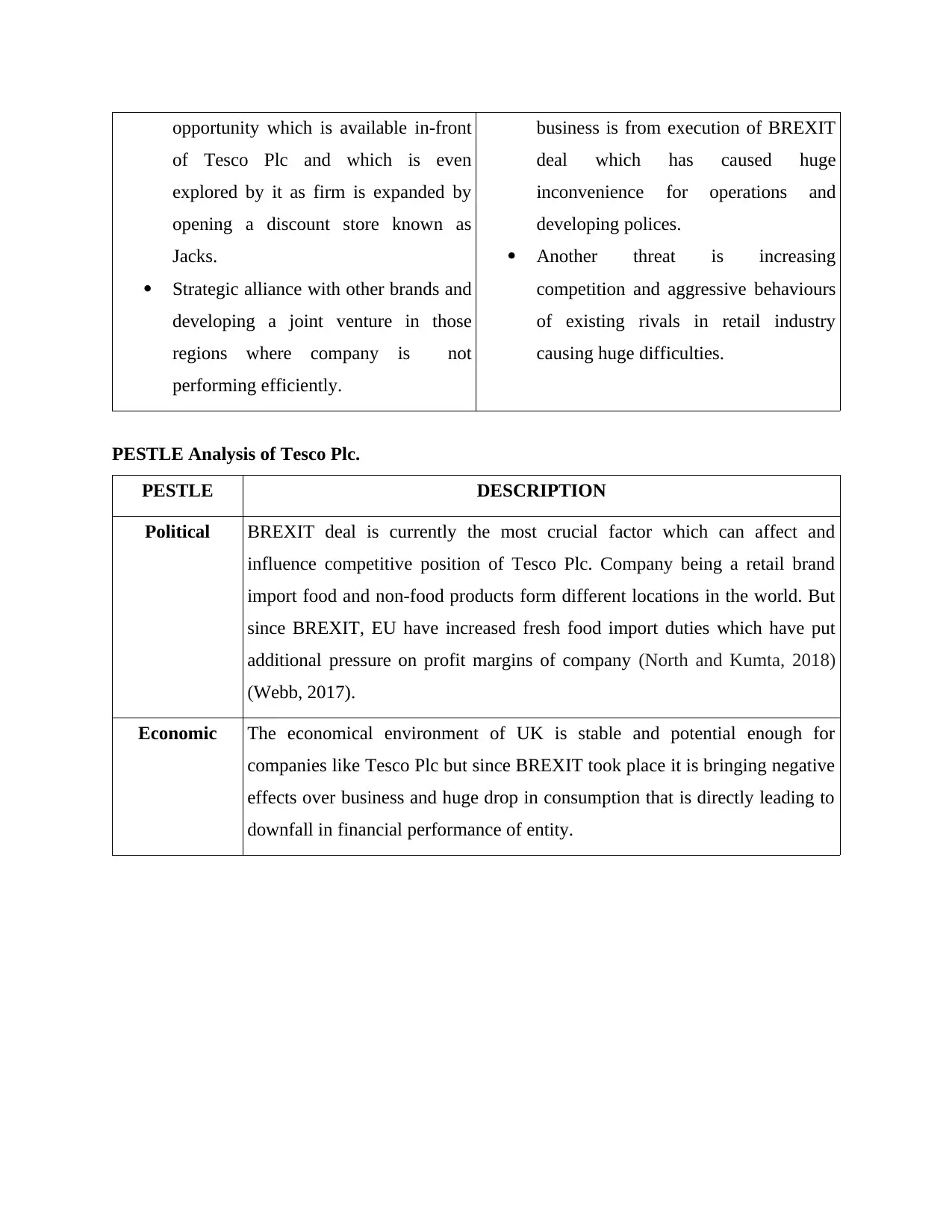
opportunity which is available in-front
of Tesco Plc and which is even
explored by it as firm is expanded by
opening a discount store known as
Jacks.
Strategic alliance with other brands and
developing a joint venture in those
regions where company is not
performing efficiently.
business is from execution of BREXIT
deal which has caused huge
inconvenience for operations and
developing polices.
Another threat is increasing
competition and aggressive behaviours
of existing rivals in retail industry
causing huge difficulties.
PESTLE Analysis of Tesco Plc.
PESTLE DESCRIPTION
Political BREXIT deal is currently the most crucial factor which can affect and
influence competitive position of Tesco Plc. Company being a retail brand
import food and non-food products form different locations in the world. But
since BREXIT, EU have increased fresh food import duties which have put
additional pressure on profit margins of company (North and Kumta, 2018)
(Webb, 2017).
Economic The economical environment of UK is stable and potential enough for
companies like Tesco Plc but since BREXIT took place it is bringing negative
effects over business and huge drop in consumption that is directly leading to
downfall in financial performance of entity.
of Tesco Plc and which is even
explored by it as firm is expanded by
opening a discount store known as
Jacks.
Strategic alliance with other brands and
developing a joint venture in those
regions where company is not
performing efficiently.
business is from execution of BREXIT
deal which has caused huge
inconvenience for operations and
developing polices.
Another threat is increasing
competition and aggressive behaviours
of existing rivals in retail industry
causing huge difficulties.
PESTLE Analysis of Tesco Plc.
PESTLE DESCRIPTION
Political BREXIT deal is currently the most crucial factor which can affect and
influence competitive position of Tesco Plc. Company being a retail brand
import food and non-food products form different locations in the world. But
since BREXIT, EU have increased fresh food import duties which have put
additional pressure on profit margins of company (North and Kumta, 2018)
(Webb, 2017).
Economic The economical environment of UK is stable and potential enough for
companies like Tesco Plc but since BREXIT took place it is bringing negative
effects over business and huge drop in consumption that is directly leading to
downfall in financial performance of entity.
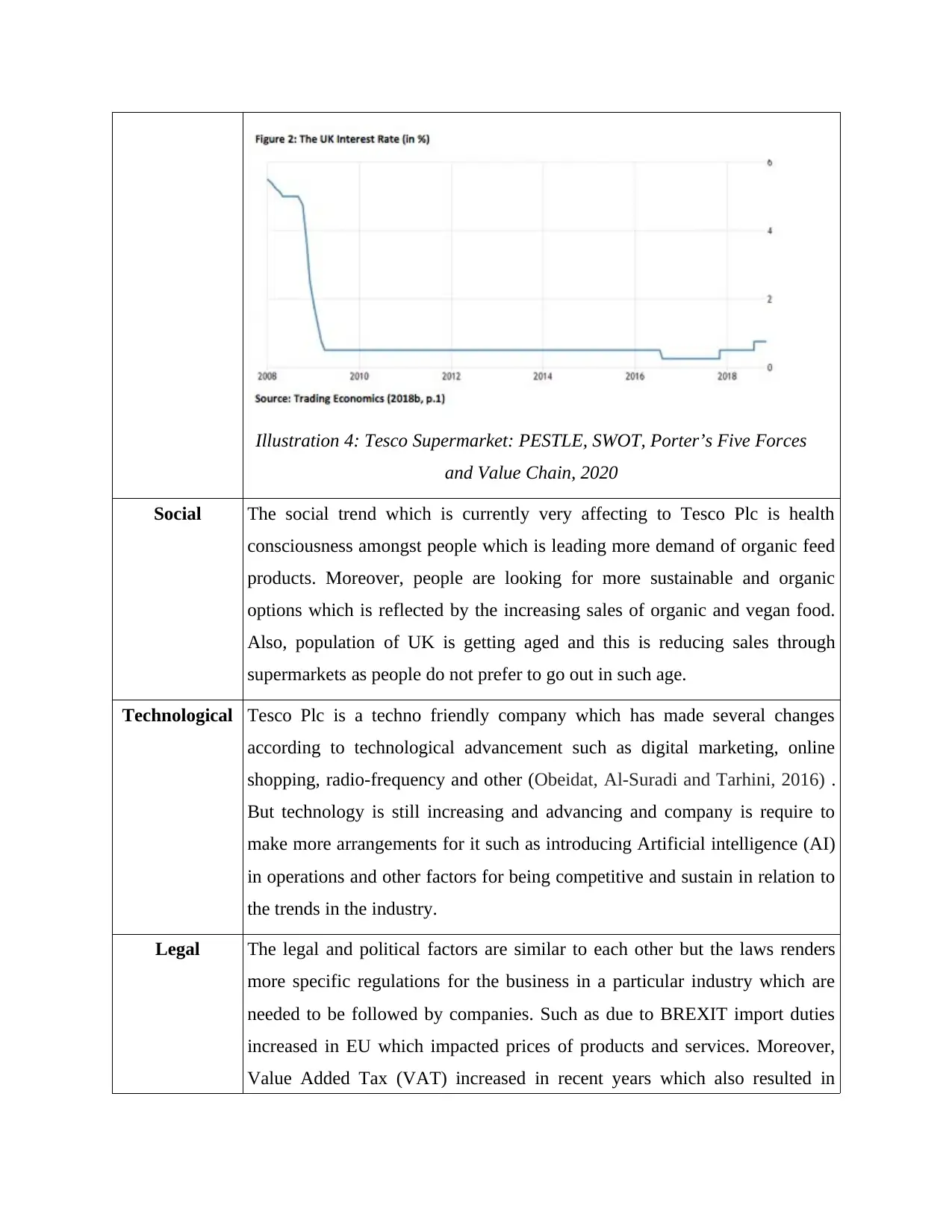
Illustration 4: Tesco Supermarket: PESTLE, SWOT, Porter’s Five Forces
and Value Chain, 2020
Social The social trend which is currently very affecting to Tesco Plc is health
consciousness amongst people which is leading more demand of organic feed
products. Moreover, people are looking for more sustainable and organic
options which is reflected by the increasing sales of organic and vegan food.
Also, population of UK is getting aged and this is reducing sales through
supermarkets as people do not prefer to go out in such age.
Technological Tesco Plc is a techno friendly company which has made several changes
according to technological advancement such as digital marketing, online
shopping, radio-frequency and other (Obeidat, Al-Suradi and Tarhini, 2016) .
But technology is still increasing and advancing and company is require to
make more arrangements for it such as introducing Artificial intelligence (AI)
in operations and other factors for being competitive and sustain in relation to
the trends in the industry.
Legal The legal and political factors are similar to each other but the laws renders
more specific regulations for the business in a particular industry which are
needed to be followed by companies. Such as due to BREXIT import duties
increased in EU which impacted prices of products and services. Moreover,
Value Added Tax (VAT) increased in recent years which also resulted in
and Value Chain, 2020
Social The social trend which is currently very affecting to Tesco Plc is health
consciousness amongst people which is leading more demand of organic feed
products. Moreover, people are looking for more sustainable and organic
options which is reflected by the increasing sales of organic and vegan food.
Also, population of UK is getting aged and this is reducing sales through
supermarkets as people do not prefer to go out in such age.
Technological Tesco Plc is a techno friendly company which has made several changes
according to technological advancement such as digital marketing, online
shopping, radio-frequency and other (Obeidat, Al-Suradi and Tarhini, 2016) .
But technology is still increasing and advancing and company is require to
make more arrangements for it such as introducing Artificial intelligence (AI)
in operations and other factors for being competitive and sustain in relation to
the trends in the industry.
Legal The legal and political factors are similar to each other but the laws renders
more specific regulations for the business in a particular industry which are
needed to be followed by companies. Such as due to BREXIT import duties
increased in EU which impacted prices of products and services. Moreover,
Value Added Tax (VAT) increased in recent years which also resulted in
⊘ This is a preview!⊘
Do you want full access?
Subscribe today to unlock all pages.

Trusted by 1+ million students worldwide
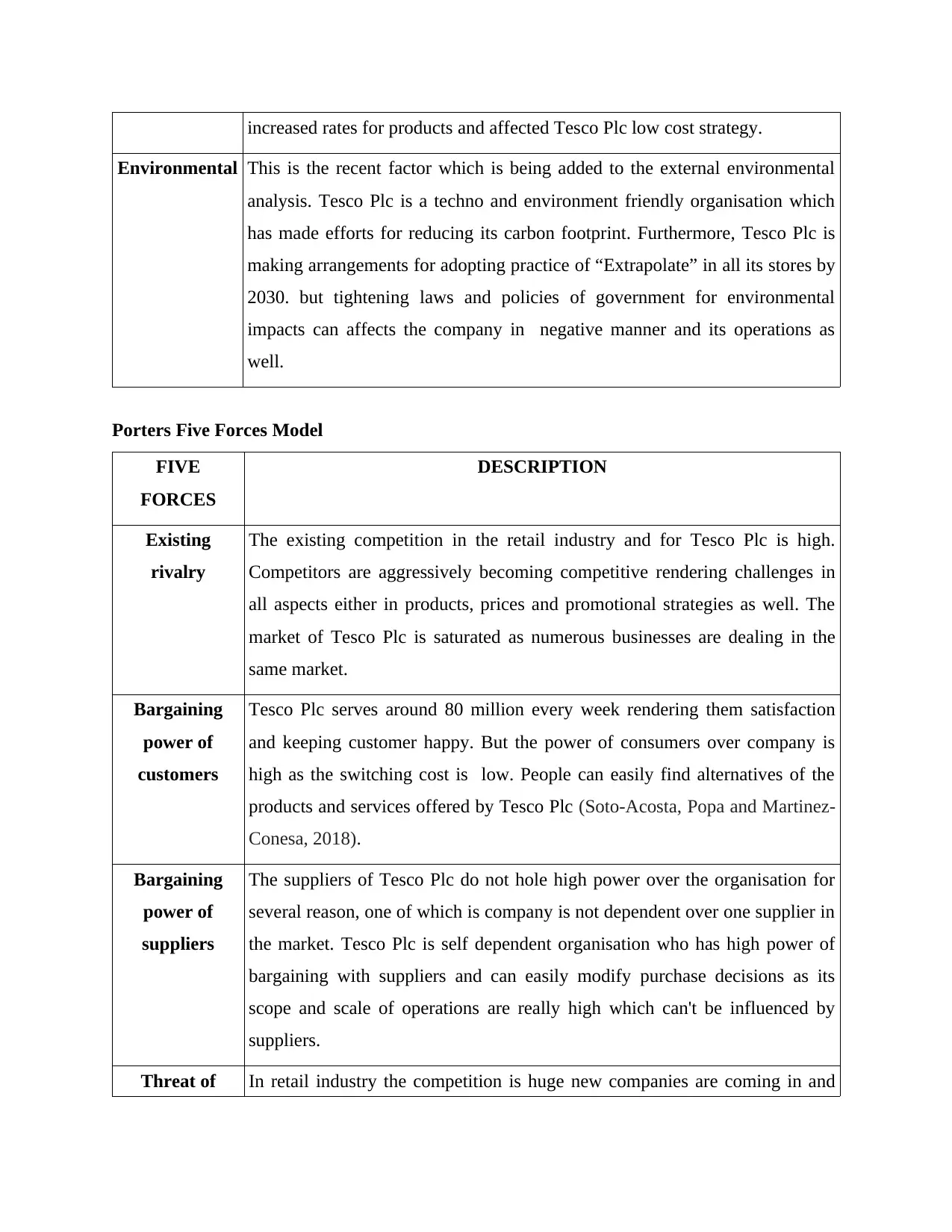
increased rates for products and affected Tesco Plc low cost strategy.
Environmental This is the recent factor which is being added to the external environmental
analysis. Tesco Plc is a techno and environment friendly organisation which
has made efforts for reducing its carbon footprint. Furthermore, Tesco Plc is
making arrangements for adopting practice of “Extrapolate” in all its stores by
2030. but tightening laws and policies of government for environmental
impacts can affects the company in negative manner and its operations as
well.
Porters Five Forces Model
FIVE
FORCES
DESCRIPTION
Existing
rivalry
The existing competition in the retail industry and for Tesco Plc is high.
Competitors are aggressively becoming competitive rendering challenges in
all aspects either in products, prices and promotional strategies as well. The
market of Tesco Plc is saturated as numerous businesses are dealing in the
same market.
Bargaining
power of
customers
Tesco Plc serves around 80 million every week rendering them satisfaction
and keeping customer happy. But the power of consumers over company is
high as the switching cost is low. People can easily find alternatives of the
products and services offered by Tesco Plc (Soto-Acosta, Popa and Martinez-
Conesa, 2018).
Bargaining
power of
suppliers
The suppliers of Tesco Plc do not hole high power over the organisation for
several reason, one of which is company is not dependent over one supplier in
the market. Tesco Plc is self dependent organisation who has high power of
bargaining with suppliers and can easily modify purchase decisions as its
scope and scale of operations are really high which can't be influenced by
suppliers.
Threat of In retail industry the competition is huge new companies are coming in and
Environmental This is the recent factor which is being added to the external environmental
analysis. Tesco Plc is a techno and environment friendly organisation which
has made efforts for reducing its carbon footprint. Furthermore, Tesco Plc is
making arrangements for adopting practice of “Extrapolate” in all its stores by
2030. but tightening laws and policies of government for environmental
impacts can affects the company in negative manner and its operations as
well.
Porters Five Forces Model
FIVE
FORCES
DESCRIPTION
Existing
rivalry
The existing competition in the retail industry and for Tesco Plc is high.
Competitors are aggressively becoming competitive rendering challenges in
all aspects either in products, prices and promotional strategies as well. The
market of Tesco Plc is saturated as numerous businesses are dealing in the
same market.
Bargaining
power of
customers
Tesco Plc serves around 80 million every week rendering them satisfaction
and keeping customer happy. But the power of consumers over company is
high as the switching cost is low. People can easily find alternatives of the
products and services offered by Tesco Plc (Soto-Acosta, Popa and Martinez-
Conesa, 2018).
Bargaining
power of
suppliers
The suppliers of Tesco Plc do not hole high power over the organisation for
several reason, one of which is company is not dependent over one supplier in
the market. Tesco Plc is self dependent organisation who has high power of
bargaining with suppliers and can easily modify purchase decisions as its
scope and scale of operations are really high which can't be influenced by
suppliers.
Threat of In retail industry the competition is huge new companies are coming in and
Paraphrase This Document
Need a fresh take? Get an instant paraphrase of this document with our AI Paraphraser
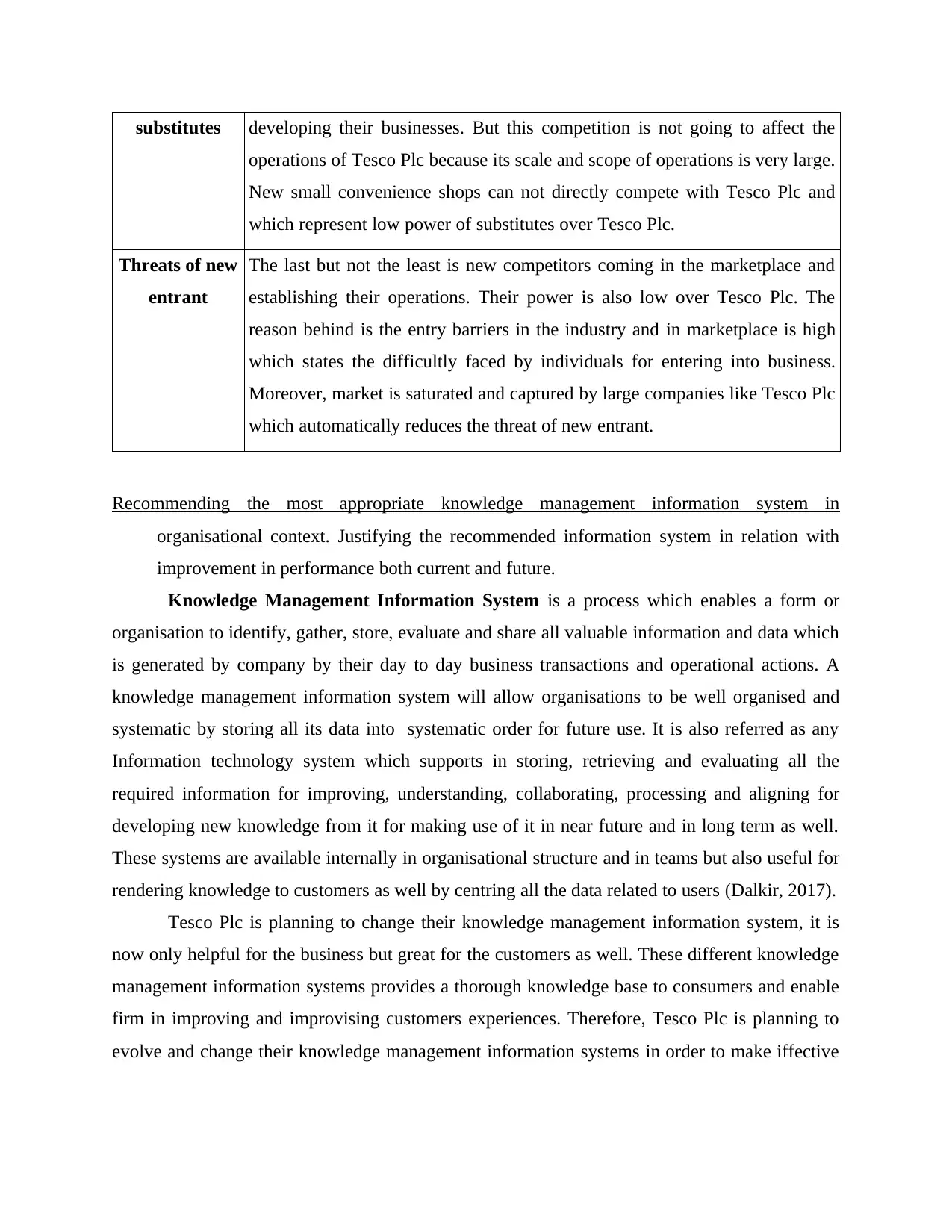
substitutes developing their businesses. But this competition is not going to affect the
operations of Tesco Plc because its scale and scope of operations is very large.
New small convenience shops can not directly compete with Tesco Plc and
which represent low power of substitutes over Tesco Plc.
Threats of new
entrant
The last but not the least is new competitors coming in the marketplace and
establishing their operations. Their power is also low over Tesco Plc. The
reason behind is the entry barriers in the industry and in marketplace is high
which states the difficultly faced by individuals for entering into business.
Moreover, market is saturated and captured by large companies like Tesco Plc
which automatically reduces the threat of new entrant.
Recommending the most appropriate knowledge management information system in
organisational context. Justifying the recommended information system in relation with
improvement in performance both current and future.
Knowledge Management Information System is a process which enables a form or
organisation to identify, gather, store, evaluate and share all valuable information and data which
is generated by company by their day to day business transactions and operational actions. A
knowledge management information system will allow organisations to be well organised and
systematic by storing all its data into systematic order for future use. It is also referred as any
Information technology system which supports in storing, retrieving and evaluating all the
required information for improving, understanding, collaborating, processing and aligning for
developing new knowledge from it for making use of it in near future and in long term as well.
These systems are available internally in organisational structure and in teams but also useful for
rendering knowledge to customers as well by centring all the data related to users (Dalkir, 2017).
Tesco Plc is planning to change their knowledge management information system, it is
now only helpful for the business but great for the customers as well. These different knowledge
management information systems provides a thorough knowledge base to consumers and enable
firm in improving and improvising customers experiences. Therefore, Tesco Plc is planning to
evolve and change their knowledge management information systems in order to make iffective
operations of Tesco Plc because its scale and scope of operations is very large.
New small convenience shops can not directly compete with Tesco Plc and
which represent low power of substitutes over Tesco Plc.
Threats of new
entrant
The last but not the least is new competitors coming in the marketplace and
establishing their operations. Their power is also low over Tesco Plc. The
reason behind is the entry barriers in the industry and in marketplace is high
which states the difficultly faced by individuals for entering into business.
Moreover, market is saturated and captured by large companies like Tesco Plc
which automatically reduces the threat of new entrant.
Recommending the most appropriate knowledge management information system in
organisational context. Justifying the recommended information system in relation with
improvement in performance both current and future.
Knowledge Management Information System is a process which enables a form or
organisation to identify, gather, store, evaluate and share all valuable information and data which
is generated by company by their day to day business transactions and operational actions. A
knowledge management information system will allow organisations to be well organised and
systematic by storing all its data into systematic order for future use. It is also referred as any
Information technology system which supports in storing, retrieving and evaluating all the
required information for improving, understanding, collaborating, processing and aligning for
developing new knowledge from it for making use of it in near future and in long term as well.
These systems are available internally in organisational structure and in teams but also useful for
rendering knowledge to customers as well by centring all the data related to users (Dalkir, 2017).
Tesco Plc is planning to change their knowledge management information system, it is
now only helpful for the business but great for the customers as well. These different knowledge
management information systems provides a thorough knowledge base to consumers and enable
firm in improving and improvising customers experiences. Therefore, Tesco Plc is planning to
evolve and change their knowledge management information systems in order to make iffective
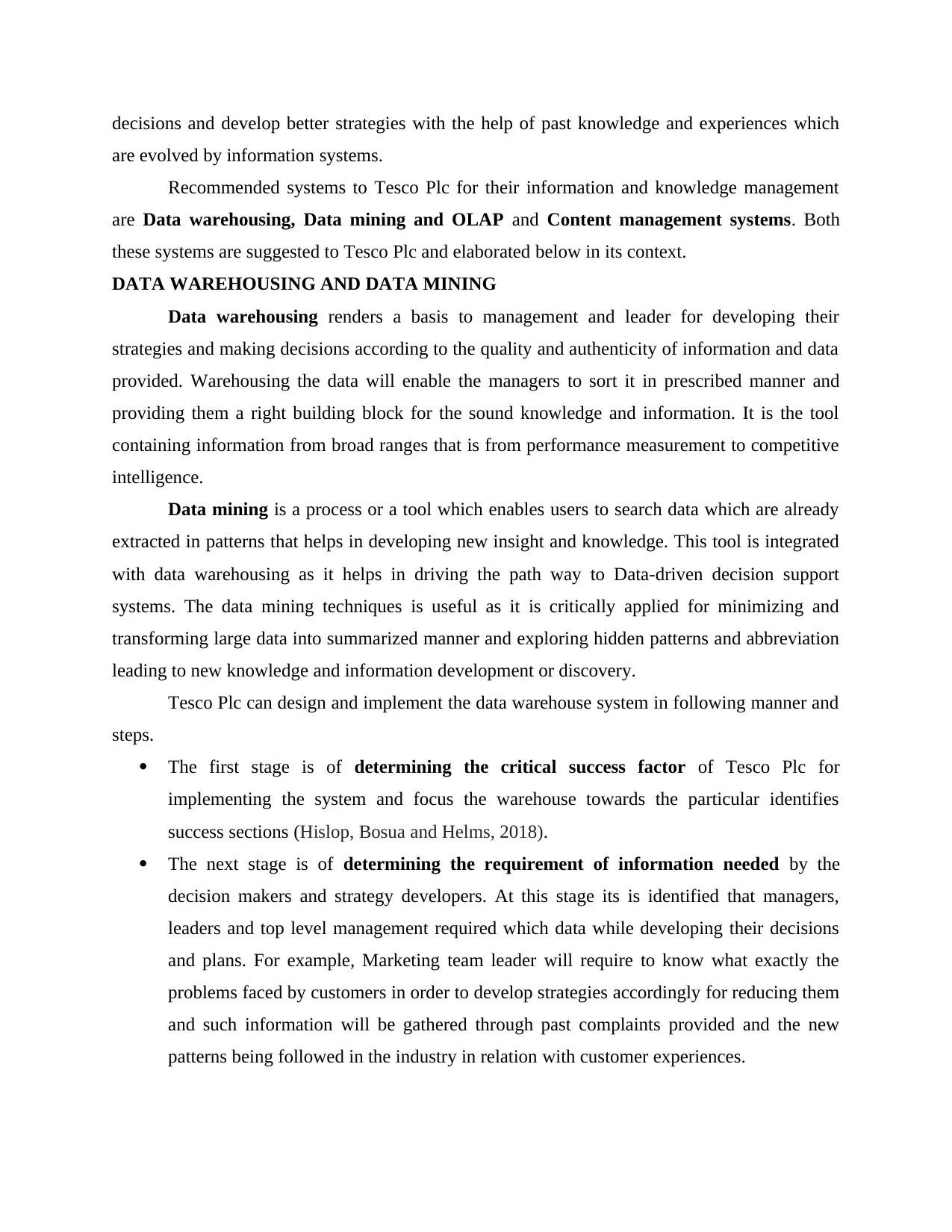
decisions and develop better strategies with the help of past knowledge and experiences which
are evolved by information systems.
Recommended systems to Tesco Plc for their information and knowledge management
are Data warehousing, Data mining and OLAP and Content management systems. Both
these systems are suggested to Tesco Plc and elaborated below in its context.
DATA WAREHOUSING AND DATA MINING
Data warehousing renders a basis to management and leader for developing their
strategies and making decisions according to the quality and authenticity of information and data
provided. Warehousing the data will enable the managers to sort it in prescribed manner and
providing them a right building block for the sound knowledge and information. It is the tool
containing information from broad ranges that is from performance measurement to competitive
intelligence.
Data mining is a process or a tool which enables users to search data which are already
extracted in patterns that helps in developing new insight and knowledge. This tool is integrated
with data warehousing as it helps in driving the path way to Data-driven decision support
systems. The data mining techniques is useful as it is critically applied for minimizing and
transforming large data into summarized manner and exploring hidden patterns and abbreviation
leading to new knowledge and information development or discovery.
Tesco Plc can design and implement the data warehouse system in following manner and
steps.
The first stage is of determining the critical success factor of Tesco Plc for
implementing the system and focus the warehouse towards the particular identifies
success sections (Hislop, Bosua and Helms, 2018).
The next stage is of determining the requirement of information needed by the
decision makers and strategy developers. At this stage its is identified that managers,
leaders and top level management required which data while developing their decisions
and plans. For example, Marketing team leader will require to know what exactly the
problems faced by customers in order to develop strategies accordingly for reducing them
and such information will be gathered through past complaints provided and the new
patterns being followed in the industry in relation with customer experiences.
are evolved by information systems.
Recommended systems to Tesco Plc for their information and knowledge management
are Data warehousing, Data mining and OLAP and Content management systems. Both
these systems are suggested to Tesco Plc and elaborated below in its context.
DATA WAREHOUSING AND DATA MINING
Data warehousing renders a basis to management and leader for developing their
strategies and making decisions according to the quality and authenticity of information and data
provided. Warehousing the data will enable the managers to sort it in prescribed manner and
providing them a right building block for the sound knowledge and information. It is the tool
containing information from broad ranges that is from performance measurement to competitive
intelligence.
Data mining is a process or a tool which enables users to search data which are already
extracted in patterns that helps in developing new insight and knowledge. This tool is integrated
with data warehousing as it helps in driving the path way to Data-driven decision support
systems. The data mining techniques is useful as it is critically applied for minimizing and
transforming large data into summarized manner and exploring hidden patterns and abbreviation
leading to new knowledge and information development or discovery.
Tesco Plc can design and implement the data warehouse system in following manner and
steps.
The first stage is of determining the critical success factor of Tesco Plc for
implementing the system and focus the warehouse towards the particular identifies
success sections (Hislop, Bosua and Helms, 2018).
The next stage is of determining the requirement of information needed by the
decision makers and strategy developers. At this stage its is identified that managers,
leaders and top level management required which data while developing their decisions
and plans. For example, Marketing team leader will require to know what exactly the
problems faced by customers in order to develop strategies accordingly for reducing them
and such information will be gathered through past complaints provided and the new
patterns being followed in the industry in relation with customer experiences.
⊘ This is a preview!⊘
Do you want full access?
Subscribe today to unlock all pages.

Trusted by 1+ million students worldwide
1 out of 17
Related Documents
Your All-in-One AI-Powered Toolkit for Academic Success.
+13062052269
info@desklib.com
Available 24*7 on WhatsApp / Email
![[object Object]](/_next/static/media/star-bottom.7253800d.svg)
Unlock your academic potential
Copyright © 2020–2025 A2Z Services. All Rights Reserved. Developed and managed by ZUCOL.





